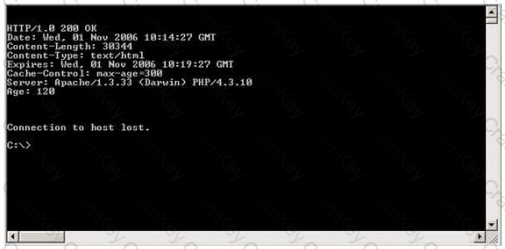| Exam Name: | Ethical Hacking and Countermeasures V8 | ||
| Exam Code: | EC0-350 Dumps | ||
| Vendor: | ECCouncil | Certification: | Certified Ethical Hacker |
| Questions: | 878 Q&A's | Shared By: | everlyn |
John the Ripper is a technical assessment tool used to test the weakness of which of the following?
Kevin is an IT security analyst working for Emerson Time Makers, a watch manufacturing company in Miami. Kevin and his girlfriend Katy recently broke up after a big fight. Kevin believes that she was seeing another person. Kevin, who has an online email account that he uses for most of his mail, knows that Katy has an account with that same company. Kevin logs into his email account online and gets the following URL after successfully logged in: http://www.youremailhere.com/mail.asp?mailbox=Kevin &Smith=121%22 Kevin changes the URL to: http://www.youremailhere.com/mail.asp?mailbox=Katy &Sanchez=121%22 Kevin is trying to access her email account to see if he can find out any information. What is Kevin attempting here to gain access to Katy's mailbox?
Blake is in charge of securing all 20 of his company's servers. He has enabled hardware and software firewalls, hardened the operating systems, and disabled all unnecessary services on all the servers. Unfortunately, there is proprietary AS400 emulation software that must run on one of the servers that requires the telnet service to function properly. Blake is especially concerned about this since telnet can be a very large security risk in an organization. Blake is concerned about how this particular server might look to an outside attacker so he decides to perform some footprinting, scanning, and penetration tests on the server. Blake telnets into the server using Port 80 and types in the following command:
HEAD / HTTP/1.0
After pressing enter twice, Blake gets the following results: What has Blake just accomplished?

After a client sends a connection request (SYN) packet to the server, the server will respond (SYN-ACK) with a sequence number of its choosing, which then must be acknowledged (ACK) by the client. This sequence number is predictable; the attack connects to a service first with its own IP address, records the sequence number chosen, and then opens a second connection from a forged IP address. The attack doesn't see the SYN-ACK (or any other packet) from the server, but can guess the correct responses. If the source IP address is used for authentication, then the attacker can use the one-sided communication to break into the server. What attacks can you successfully launch against a server using the above technique?